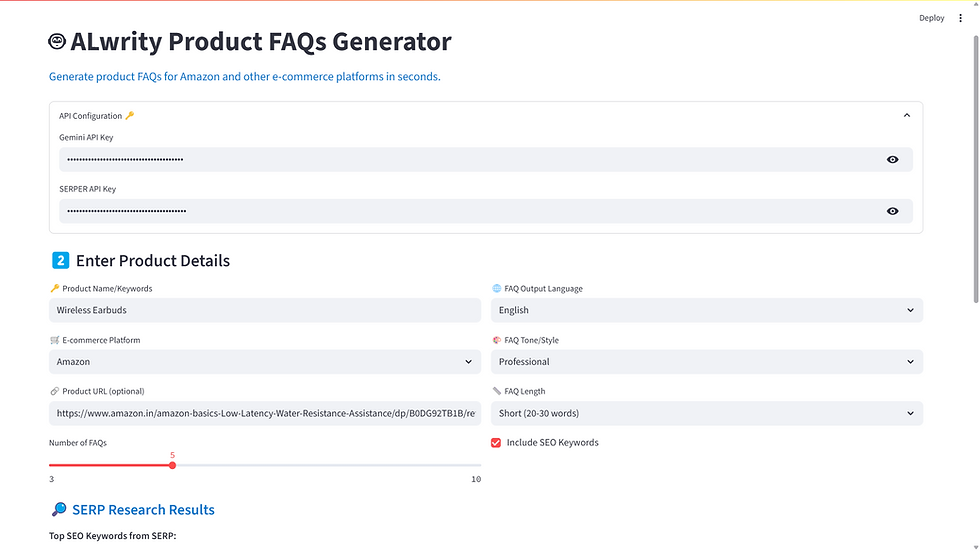Alwrity’s Free On-Page SEO Analyzer
- DikshaAI
- Aug 25, 2024
- 4 min read
The world of Search Engine Optimization (SEO) can be a complex one, filled with technical jargon and ever-changing best practices. But achieving top rankings in search results is crucial for online success, and understanding on-page SEO is a key starting point.
Today, we're going to introduce a powerful tool – an interactive SEO analyzer – that can help you gain valuable insights into your website's SEO health.

What is On-Page SEO?
On-page SEO refers to the optimization of individual web pages within your website to make them more visible and appealing to search engines. It involves optimizing the content, code, and structure of each page to improve its ranking potential.
On-page SEO is the practice of optimizing the individual pages on your website so that search engines like Google can understand them better. This includes everything from your content and HTML tags to internal links and image alt text. Properly optimizing these elements improves your chances of ranking higher in search results, which means more traffic, more engagement, and more conversions for you.
Why Content Creators and Digital Marketers Should Care
If you're a content creator or a digital marketer, you know that great content is only half the battle. Without the right SEO in place, even the most brilliant blog post or landing page can get buried in the sea of online noise.
But here's the deal: mastering SEO doesn't have to be a full-time job. With Alwrity's SEO Analyzer, you can pinpoint exactly what needs fixing on your pages without needing to be an SEO expert.
Meet Your New SEO Sidekick: Alwrity’s On-Page SEO Analyzer
Built with content creators and digital marketers in mind, our SEO Analyzer takes all the guesswork out of optimizing your website. Whether you're looking to improve your blog's searchability, refine your landing pages, or ensure your content is easily shareable across social media platforms, this tool has you covered.
1. Meta Data:
Title: The title tag is the primary headline for your page, displayed in search results and often serves as the clickbait. Aim for clear, concise titles that accurately reflect the content on the page and use keywords relevant to your topic.
Meta Description: The meta description tag summarizes your content in a short, enticing way, appearing in search results snippets. It helps draw people to your page. Aim for a description that's compelling and relevant to your content.
Robots Directives: These tags provide instructions to search engine crawlers about how they should treat your page. For example, you might tell a crawler to not index certain pages or follow links from those pages.
Viewport: The viewport meta tag ensures your website looks good and functions well across different screen sizes (like desktops, tablets, and smartphones). A responsive website improves user experience and is crucial for SEO as Google prioritizes mobile-friendly sites.
Charset: Specifies the character encoding for your website. Using the right character set is essential for displaying content correctly and ensuring your site is accessible globally.
Language: Indicates the main language of the page. This helps search engines understand the language of your content and present relevant results.
2. Canonical and Hreflangs
Canonical: The rel="canonical" tag points search engines to the preferred version of a page. It's vital for avoiding duplicate content issues (having multiple URLs with similar content).
Hreflangs: These tags are crucial for websites with multilingual content. They tell search engines which version of your page should be shown to users in different countries or language regions.

3. Schema Markup
Structured Data: Schema markup, like JSON-LD, helps search engines better understand the content of your web pages. Think of it as a structured way to add semantic information about the page's subject. For instance, you could specify that a page contains a "Product", an "Article", an "Event", or a "Recipe."
Rich Snippets: Schema markup can make your search results richer, including things like review stars, price, availability, or images, potentially improving your click-through rate.
4. Content Data
Text Length: Aim for at least 300 words of content. Search engines favor longer, in-depth content that provides value to users.
Headers (H1-H6): Using headers properly helps structure your content and improves readability. A clear H1 tag should summarize the main topic of your page.
Images: Images can be a big part of attracting attention, but they must be optimized for SEO. Ensure all images have alt text descriptions. This helps accessibility for visually impaired users and also provides search engines with context about the image.
Internal and External Links: Internal links help connect different pages within your site, making navigation easier. Links to high-quality external websites can provide valuable information for users, demonstrating your credibility and understanding of your topic.
5. Open Graph Data
Social Media Sharing: Open Graph tags are used to control how your website's content appears when shared on social media platforms like Facebook, Twitter, and Pinterest. They make sure you get the best possible representation (title, description, image preview) of your page when it's shared.
6. Social Tags
Twitter Cards and Facebook Open Graph: These tags help optimize the appearance of your content when it's shared on these specific social networks.
7. Performance Metrics
PageSpeed Insights: This section retrieves your website's PageSpeed Score from Google. Page speed is important for SEO because fast-loading websites provide a better user experience, which is a ranking factor.

8. Mobile Usability:
Mobile-First Indexing: Google primarily uses the mobile version of your website for indexing and ranking. The viewport meta tag is crucial for ensuring that your website is responsive and user-friendly on mobile devices.
9. Accessibility:
Alt Text: Adding alt text descriptions for images is vital for accessibility. It helps screen readers, which convert text into speech for visually impaired users, to understand the image.
You'll be presented with a detailed table of SEO information, broken down by categories. For each element, you'll find:
The actual value (title, description, canonical URL, image URLs, etc.)
Recommendations on what you could improve, and an explanation of why the suggestion is beneficial.
Additional Notes:
The Google PageSpeed Insights API key is not provided, as you need to obtain it yourself. Refer to the documentation for Google PageSpeed Insights (https://developers.google.com/speed/docs/insights/v5/getting-started).
This tool is meant to provide an initial SEO assessment. You should always double-check the recommendations against current SEO best practices.
By using this SEO Analyzer and considering the information provided in this blog, you'll be better equipped to optimize your website and climb the search engine rankings.





Comments